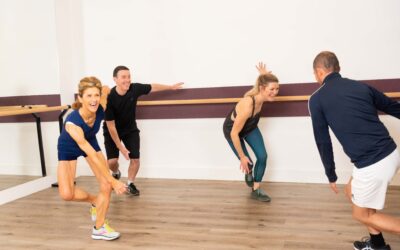Introduction
It is widely known that maintaining and building aerobic fitness is an important factor in staying healthy as we age. I have written about it myself in blogs on aerobic training (click here) and its positive effects on keeping cardiovascular diseases at bay (click here).
The measure of fitness that less attention is paid to when it comes to its effect on our health is muscular strength. That’s all changing, however, as the recent spate of articles in the mainstream media linking muscle strength to health and lifespan have shown. This recent article from the Guardian is an example.

Strength training is important
Strength training, or weight training, or resistance training as it is also known, helps to reverse the loss of muscle mass that occurs with aging. This process of muscle wastage is known as sarcopenia.
In his book Outlive (1), scientist and researcher Peter Attia highlights some of the recent data, including the fact that muscle mass declines steeply after age 65 and even more so after age 75. He states that, by age 80, the average person has lost around 8kg of muscle.
Muscle mass itself is not the be-all and end-all. The strength of the muscles (how much force that the muscles can exert) is also key – when lifting the shopping or decorating the spare room, for example. According to kinesiology expert Andy Galpin, we lose strength 2-3 times more quickly than muscle mass. He states that this is because the biggest single change in aging muscle is the atrophy (wastage) of type 2 muscle fibres. These are the fibres that give us strength and power (in contrast to type 1 fibres, which give us endurance). Therefore we must do challenging strength training to stimulate the maintenance and growth of crucial type 2 muscle fibres.
The effects of maintaining and increasing muscle mass and strength
There are benefits in maintaining and growing muscle mass and strength for how long we live and how healthily we live in old age.
Lifespan
Studies have shown that those with lower muscle mass are at a higher risk of all-cause mortality than those with more muscles. Peter Attia cites evidence that, in a study of 4,500 people aged 50 or older, those with low muscle mass were at up to 40-50% greater risk of death than people with higher muscle mass. The effect was also compounded when muscle strength was taken into account – stronger people had a lower risk of death than weaker ones.
Healthspan
Most people are familiar with the term “lifespan” and know exactly what it means – how long someone lives. It is a widely accepted measure of the health of a population. Healthier populations live longer than unhealthy ones. But what about how healthily we live our lives, particularly in our later years? This is the increasingly commonly discussed concept of “healthspan, a term best described by Dr. Michael Greger as, “living healthily is not just about putting years on your life, it’s about putting life into your years.” For me, the definition of healthspan is about quality of life. Living the later years of one’s life as an active person is far preferable to a sedentary life where the body’s systems are kept going by a series of prescription drugs while everyday tasks can only be performed by the assistance of carers.

There are many examples of how maintaining and increasing strength and muscle mass play crucial roles in improving healthspan. Here are the results of some of those effects:
- Improvements in balance and coordination, leading to a reduction in accidents and falls. This is one area where lifespan and healthspan overlap because the prognosis from falls (possibly resulting in a hip or femur fracture) for older people is so poor.
- Increases in the ability to do aerobic exercise and the subsequent benefit from all of the health improvements that come with it. Strong muscles are the foundation of health and fitness. We all know of the benefits of regular aerobic exercise (see my blog here), but it is the baseline of strong muscles that allows for this aerobic exercise to be done.
- Improvements in the ability to do everyday activities. As we get older it is less likely that we will be exercising to train for a sporting challenge. We will probably be exercising for health, particularly so that we can go about our day with less struggles and strains. Stronger people find everyday life more enjoyable when they can accomplish activities like climbing the stairs, walking the dog, and playing with their grandchildren with ease.
- An expansion in the possibilities for living independently, leading to all of the mental health benefits that come with it. Older people with stronger muscles are much more likely to be able to live independently in their own homes than people of the same age who have suffered from significant loss of muscle mass and strength.
- Stronger muscles are associated with the maintenance and increase in bone mineral density (BMD), which helps to stave off the development of osteoporosis (brittle bone disease). People with osteoporosis are much more likely to suffer a hip or femur fracture if they have a fall. The prognosis for people aged over 65 who have a fall is grim with 15 to 36% dying within one year (1). The best way to keep BMD high is to regularly take part in load bearing activities such as weight training.
- Recent studies by Dr Andy Galpin, highlighted on the Zoe Podcast (2), have shown that grip strength is a predictor of cognitive health. He explains that this is because the neurological demand of strength training is very high. Lifting heavy weights engages more muscles, which are all connected to the brain by nerves, therefore more nerves fire and more brain activity is registered.
I am convinced by all of the evidence listed above, even the very new research about strength training and brain health. Of course the next question is, how do we maintain and improve muscle mass and strength? That’s the topic of my next blog along with a series of workouts and “how to” videos.
References
1 Attia, P (2023) Outlive – the Science and Art of Longevity. Vermillion.
2 The easy exercise that’s huge for your brain health | Dr Andy Galpin. The Zoe Podcast. https://youtu.be/hI073oP0C-c?si=NH7C5rA0zMuYQhoZ accessed 18/04/2024





